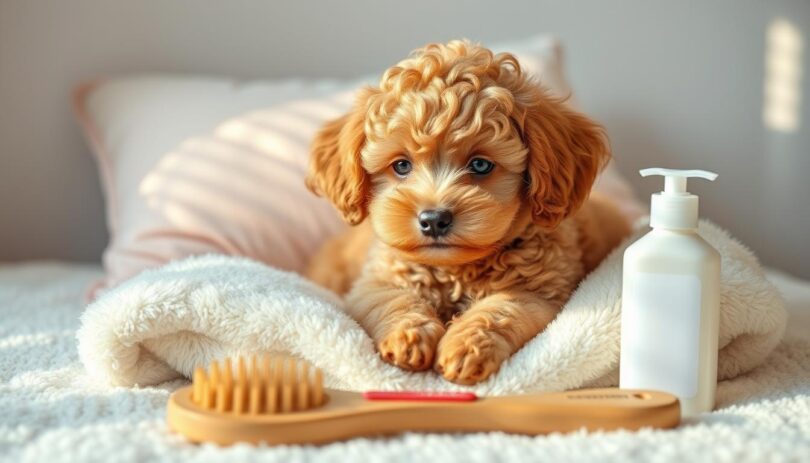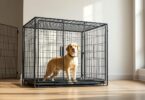What if everything you thought about raising a poodle was only half the story? While many admire these curly-coated companions for their elegance, few realize the depth of care and strategy required to nurture their full potential. This guide reveals expert-backed methods to transform your approach – blending centuries-old wisdom with modern science.
Originally bred as water retrievers in Europe over 400 years ago, these intelligent dogs now rank among America's most popular family pets. Their hypoallergenic coats and adaptable nature make them ideal for various homes, from apartments to suburban houses. But their sharp minds demand more than basic care – they thrive on structured routines and mental challenges.
You'll discover how to:
- Decode distinct personality traits across Standard, Miniature, and Toy varieties
- Create daily schedules balancing exercise, training, and bonding time
- Master grooming techniques endorsed by The Poodle Club of America
Recent studies show proper early socialization reduces separation anxiety by 62% in this sensitive breed. We've distilled insights from top veterinarians and breeders into actionable steps, including nutrition plans using premium foods like Royal Canin. Whether you're a first-time owner or seasoned enthusiast, these strategies help build an unbreakable bond with your new companion.
Understanding the Poodle Puppy: Breed Insights & History
Behind every curly-haired companion lies a rich legacy of purpose and adaptation. These dogs evolved from skilled hunters to beloved household members through centuries of selective breeding.
Origins and Development
Originally bred in Germany as water retrievers, the breed's name derives from “pudel” – German for “splash.” Their waterproof coats and athletic build made them ideal for retrieving ducks. French nobility later refined smaller versions, leading to today's Miniature and Toy varieties.
American breeders developed the Toy poodle in the 1920s for urban living. Despite size differences, all three types share the same intelligence and hypoallergenic coat traits. The Poodle Club of America confirms this genetic consistency across sizes.
Traits and Temperament
Modern companions retain their ancestors' problem-solving skills and loyalty. Studies show they learn commands 40% faster than average dogs, thriving on interactive play and mental challenges.
Their constantly growing hair requires monthly grooming – a practice rooted in historical working needs. Understanding this background helps owners create effective care routines. Proper insurance plans can offset grooming costs over time.
Whether standard or toy, these dogs adapt well to family life. Their alert nature makes them excellent watchdogs, while their playful demeanor suits homes with children.
Essential Poodle Puppy Care and Daily Needs
Balancing activity and grooming forms the foundation of healthy development. These intelligent dogs thrive on predictable schedules that meet their physical needs while preventing boredom.
Structured Activity for Balanced Growth
Start with two 15-minute walks spaced throughout the day. Morning sessions boost metabolism, while evening strolls aid digestion. Add three 10-minute play periods using puzzle toys that reward problem-solving.
Rest intervals prevent overstimulation. Crate training helps puppies recharge between activities. This rhythm supports joint health in growing dogs without exhausting them.
Coat Care Made Manageable
Brush the curly coat daily using a slicker brush. Work from skin outward to prevent mats. Focus on friction areas like behind ears and under legs first.
Schedule professional trims every 5 weeks. This maintains coat health and reduces home maintenance time. Many owners use pet insurance to offset grooming costs over the years.
Introduce nail clippers and dryers early. Pair handling with treats to create positive associations. Consistent routines help families stay ahead of grooming challenges.
Health Considerations for Your Poodle Puppy
Proactive care today prevents costly health challenges tomorrow. These intelligent companions require tailored health strategies that address breed-specific risks while promoting lifelong wellness.
Common Health Issues and Preventative Care
Toy varieties face unique genetic challenges. Progressive retinal atrophy affects 12% of these dogs, while patellar luxation occurs in 1 out of 5 smaller breeds. Legg-Calve-Perthes disease demands early screening through orthopedic exams.
DNA tests now identify 95% of inherited conditions. Combine this with portion-controlled meals and low-impact exercise to protect joints. Weekly ear checks prevent infections common in floppy-eared varieties.
Screening, Insurance, and Vet Guidance
Pet insurance covers 70-90% of unexpected costs when chosen early. Reputable providers like Healthy Paws offer breed-specific plans matching common needs.
Schedule bi-annual vet visits during the first two years. Watch for head shaking (ear issues) or bad breath (dental concerns). Responsible breeders provide OFA certifications proving health testing across generations.
Raising Your Poodle Puppy: Training and Socialization Strategies
Building trust through thoughtful engagement creates confident, well-adjusted companions. These clever dogs excel when training combines mental challenges with relationship-building moments.
Positive Reinforcement Techniques
Reward-based methods work best for toy poodles. Use bite-sized treats paired with verbal praise immediately after desired actions. Clicker training helps mark precise moments of success during effective techniques like “sit” or “stay.”
Keep sessions under 10 minutes to maintain focus. Gradually introduce commands like “leave it” or “wait” once basics are mastered. Consistency across family members prevents confusion.
Interactive Play and Mental Stimulation
Rotate puzzle toys weekly to challenge problem-solving skills. Hide treats in snuffle mats or layered boxes to engage natural hunting instincts. Agility courses using household items build coordination while burning energy.
Socialization should involve controlled exposures. Arrange playdates with vaccinated dogs and introduce various surfaces/textures during walks. Many owners use pet insurance to cover unexpected incidents during these interactions.
Structured playtime strengthens bonds better than passive cuddling. Teach “fetch” with two identical toys to practice release commands. This approach nurtures intelligence while preventing destructive behaviors.
Grooming, Ear, and Eye Care Essentials
Proper coat maintenance goes beyond aesthetics – it's vital for preventing skin issues and ensuring comfort. Curly-haired breeds require specialized routines to keep their distinctive fur healthy and mat-free.
Daily Grooming and Bathing Practices
Start with a slicker brush to detangle the coat daily. Work in sections, lifting hair away from the skin to prevent pulling. Follow with a metal comb to catch smaller knots, especially behind ears and under legs.
Bathe toy poodles every 3 weeks using pH-balanced shampoos like Chris Christensen Spectrum One. Blow-dry on low heat while brushing to maintain curl patterns. Trim nails monthly to avoid overgrowth affecting posture.
Maintaining Clear Eyes and Clean Ears
Wipe eye corners daily with saline-soaked cotton pads. For tear stains, use enzymatic cleaners like Artero Pretty Eyes. Avoid products containing alcohol near sensitive areas.
Check ears weekly for redness or odor. Apply K9 Ear Solutions with cotton balls, never inserting tools into the canal. Many owners use pet insurance to offset professional grooming costs every 4-6 weeks.
Consistent care routines reduce vet visits by 30% in toy breeds. Pair grooming sessions with treats to create positive associations. This approach keeps your companion healthy while strengthening your bond.
Nutrition and Dietary Guidance for Poodle Puppies
Fueling your companion's growth requires more than just filling a bowl. Smart nutritional choices support bone development, energy levels, and lifelong health – especially for smaller varieties with unique metabolic needs.
Choosing Complete and Balanced Dog Food
Select foods meeting AAFCO standards for puppies or multi-stage formulas. Look for quality proteins like chicken by-product meal and complex carbs such as brewers rice. Omega-3 fatty acids in salmon oil promote brain development and coat health.
Specialized formulas from brands like Royal Canin offer breed-specific kibble sizes. These support proper chewing in toy varieties while delivering concentrated nutrients. Avoid fillers like corn syrup that spike blood sugar.
Understanding Feeding Portions and Schedule
Feed ¼ to ½ cup portions 3-4 times daily for dogs under 6 months. Split 3810 kcal/kg food into meals every 4-6 hours. This prevents hypoglycemia risks in toy breeds.
Adjust portions monthly as your companion grows. Treats shouldn’t exceed 10% of daily calories. Track weight changes and consult your vet to refine quantities. Consistent meal times stabilize energy between play sessions.
Final Reflections on a Joyful Journey with Your Poodle Puppy
The path to raising a thriving toy poodle weaves together historical insights, modern care strategies, and countless heartwarming moments. From understanding their water-retrieving origins to mastering hypoallergenic coat maintenance, each aspect of care strengthens the human-canine partnership.
Consistent routines in nutrition, exercise, and mental stimulation create confident companions. Early socialization paired with positive reinforcement builds trust, while proactive health screenings help prevent common breed-specific concerns. Regular grooming sessions become bonding opportunities that maintain both physical health and that signature curly appearance.
New owners should revisit this guide's sections as their toy grows, consulting veterinarians to tailor advice. Selecting ethical breeders and maintaining checkup schedules establishes lifelong wellness foundations. The commitment required pays dividends in loyalty and affection from these intelligent dogs.
Through attentive care and mutual respect, families discover that toy poodles aren't just pets – they're enthusiastic participants in life's adventures. The journey ahead promises shared learning, laughter, and the deep satisfaction of nurturing a remarkable companion.
FAQ
What’s the best way to manage grooming costs for a Toy Poodle?
Regular at-home brushing and using quality tools like Chris Christensen brushes can reduce professional grooming trips. Pair this with a high-yield savings account (like Ally or Marcus) to set aside funds for routine trims and ear cleaning.
Do Toy Poodles need pet insurance?
Many owners opt for plans from providers like Healthy Paws or Trupanion, as the breed may develop issues like hip dysplasia or eye conditions. Insurance helps offset unexpected vet bills while preventative care savings accounts cover routine checkups.
How much exercise do Toy Poodles require daily?
Aim for 30–45 minutes of activity split between walks and mental stimulation. Puzzle toys from Outward Hound or interactive games keep their minds engaged while preventing boredom-related behaviors.










Leave a Comment